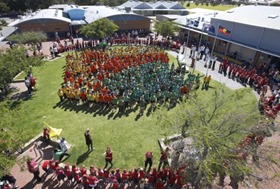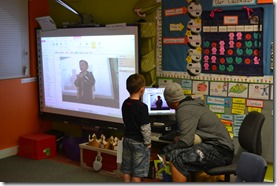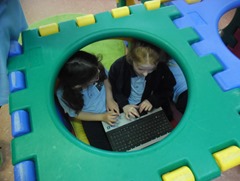PiL Program Spotlight – Quinns Beach Primary School
Quinns Beach Primary School (QBPS) is a level 5 school situated 15 kilometres north of Joondalup. Students attending the school are characteristically from the suburb of Quinns Rocks. There are currently 680 students enrolled from P-7. The school is a member of the 2012 Partners in Learning Innovative Pilot Schools program and RUMA network and is the 2012-2013 host school within the network. As a school we are committed to pioneer the use of technology to improve student learning. The school’s vision includes the words inspire and engage the digital learners of the 21st century. This is the story of a school’s 21st Century instructional practice. This article is for interested educators who might benefit from the reflective practice thus far.
Background
QBPS opened in 2001 as a lighthouse ICT School with a strong focus on innovation and e-learning. As part of the innovation the admin (PC driven) used Hoblink a unique piece of software from Germany which allowed interaction between the admin and curriculum. Students at this time were typically able to establish a web page within minutes, 45% of the parents were connected to the school through ICT and the learning facilitators’ implemented project based learning programs.
Providing reliable infrastructure
The need to work within the department capabilities has been a consistent intention for the leadership of the school as the ICT journey can be a slow and frustrating one at times. In 2007 the opportunity to access greater expertise, support and services through the department came with the Learning with ICT (LWICT) 100 schools project. The ability to utilise the strengths of the ICT teams within the department is seen as an essential component for ongoing growth and development of both infrastructure and professional learning within the school. The improved learning opportunities for students utilising ICT resulted in a focus on enhanced student engagement in the learning processes as well as raising student competence through online student learning. It was seen as a way for the school leadership to support and harness the capacity of teachers experience in the use of ICT in teaching and learning.
Personalising and extending student learning
By 2008 QBPS teachers were maximising the use of online resources and able to create lesson plans, store and share with one another online. This further enabled a collaborative approach which included other teachers, curriculum leaders and parents. Audio and visual teaching resources were included and the installation of IWBs saw students interacting with technology tools for information and data in all learning areas individually, with instruction and co-operatively. Teachers were able to monitor and provide feedback where needed. Through innovation and use of other online tools students were able to work cooperatively on projects giving relevant peer feedback during online tasks. This was accessed through the Online Teaching and Learning System (OTLS) of which we were a participant.
Connecting learning beyond the school
As successful students QBPS students are able to competently use technology to assist their learning. The need to ensure our students have the ability to ethically use technology is critical in this dynamic, connected world of communication and learning. Cyber safety pamphlets, parent information/quizzes and students completing home studies in which they apply ethical and social practices online are all seen as safe cyber strategies utilized by the school. In 2009 we began to explore the possibility of utilising ICT as a tool to support deep learning. The increased number of laptops in classes for students required the installation of new switches to each block to ensure a more reliable connectivity. As a way to connect learning beyond the school we became part of the Parent Portal trial later Connect. Teachers were encouraged to post objects for parents similar to a class noticeboard. Planning and consultation for the new school website was completed and launched in 2011. We are now available on www.quinnsbeachps.wa.edu.au
Support professional learning
As a further commitment to innovation and ICT, a third associate principal Innovation/ICT was appointed in 2010 which coincided with QBPS being selected by the Department of Education and Microsoft as one of Australia’s most advanced users of technology in the classroom. The initial phase of the project selected the principal and two staff members to commence face to face events across Australia. As an innovative pilot school for Microsoft Partners in Learning we have;
- measured key elements of the ITL Research Model, including the extent of innovative teaching practices educators use in the school
- held discussions and reflection within the broader community
- transferred the findings which have informed strategic planning and professional learning
- participated as a school in the PILSR international community of educators
The current capacity to trial new products through the Early Adapter Program includes the Web.2.0 tools, Microsoft OneNote 2010 for teachers’ interactive lesson planning, by students as e-portfolios and recording and self-reflection tools. Training of teams to use software is rolled out through face to face, online and blended learning opportunities during TeKnowledg-e-Tuesday cafés and staff development days. Staff access professional learning through live and recorded seminars with global thought leaders via Virtual University Webinars anywhere, anytime. In addition, our collaborative teams are able to create their own professional communities on Connect and the Partners in Learning Network
Enabling leadership
The 21st century skills committee (the early adapters) meets regularly to review innovative practices, the school vision and planning using the innovation framework outlined in the Innovative Schools Toolkit. (http://www.is-toolkit.com). As a further enabler an integral commitment from the senior leadership team to build their own capacity to lead innovation has developed a sense of professional practice and connection beyond the school and into other communities. Tools for online PLN include Connect, Twitter, Pinterest, LinkedIn, Ning and Windows Sky Drive.
We can be followed on Twitter @QuinnsBeachPS, @RumaNetwork and through your request be added to the PLN http://www.rumanetwork.ning.com
The training of an accredited ICT coach this year will further develop shoulder to shoulder support and enable staff to personalise and extend student learning. Leading curriculum change at QBPS involves teachers reviewing and incorporating the ICT General Capabilities in English, Maths, Science and History where possible. Student achievement is mapped on the QBPS ICT continuum with identified student leaders- known as the HOTT team (helping others with technology team) currently utilising their own capabilities to instruct and coach within the extension program of the school.
THE FUTURE FOR US
Providing reliable infrastructure
The current hardware provision is 160+ devices mostly laptops with 30 more to be purchased in 2012. A lease arrangement for Year 4 students to purchase their own laptops will commence in 2013. The 28 classes have IWBs installed and the school is networked with CAT-5 cables. The wireless reliability is still presenting problems which can deter some teachers from confidently using technology on a daily basis. We are therefore currently looking at an upgrade with extra WAPs and a WLAN controller partly resourced by the department through LWICT program. To support maintenance panel integrator is now engaged on a yearly basis.
Knowledge building
The schools’ research project using innovative teaching practice and learning activities is looking to see how younger students engage and improve in oral language. The inquiry is based on the assumption that through story telling student engagement with ICT tools including; flip video cameras, USB microphones, digital cameras, a closed YouTube channel and a global project will result in positive outcomes. The use of ICT, student centred learning and extension beyond the classroom is seen as innovative practice. This research project will be shared within the broader Partners in Learning Network in December, 2012.
Innovative teaching
Progress for QBPS as a school is viewed from the perspective of building a culture of change, with each of us observing those changes in teaching practices and then engaging through dialogue and deeper reflection to improve learning. The collaboration within the school community will continue to find ways to expand innovative teaching practices. An example is the student digital photographic competition whereby students explore their surroundings and communities looking for an altered perspective. By harnessing the innovative capacity of staff and providing the opportunities to put their ideas into effect, QBPS students will achieve the improvement in student performance we are seeking. In this way QBPS teachers work to support student skills for life and work today by providing the learning experiences in the 21st Century.
Aileen Jones; Principal, Bhavneet Singh; Associate Principal, Bec Bentley; Senior Teacher
Published article in Words, Volume 32, No.2, June 2012, a West Australian Primary Principals’ Association Inc. publication, a journal for school leaders.


